Beginner's Guide to Fostering a Rabbit
Pet rabbits are abandoned and dumped for all kinds of reasons. Here is how you can work with your local rescue and become a foster home for a rabbit.
FOSTERING
Odhrán Roche
11/28/20236 min read
To be a good rabbit foster parent, you must cover three key responsibilities:
Keep your rabbit safe
Keep your rabbit healthy
Keep your rabbit happy
This article will help you fulfill all three responsibilities, making your foster experience a happy and successful one for you and your foster rabbit.
1) Keeping your rabbit safe
Living conditions
Ideally, your foster rabbit should be allowed to free roam in at least one room of your home. Set up a special area for food, water, and hay to limit the mess.
If you're not ready to allow your foster to free roam unsupervised, you can give them their own space with a playpen. If your rabbit is restricted to a playpen, provide supervised time outside the pen for at least one hour per day. Keep in mind that most rabbits will be able to jump out of a playpen that has no cover (maybe not at first, but they will figure it out).
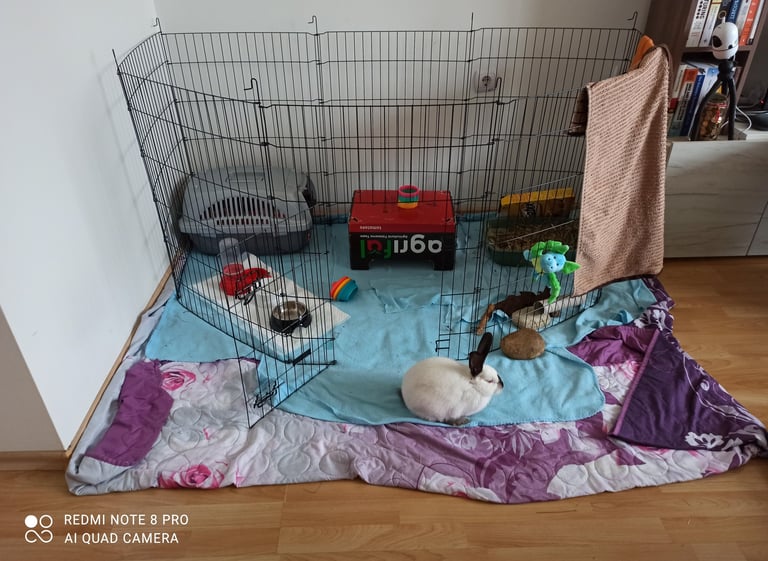

Electric cables
Some bunnies love to chew on cables. Even if your foster bun doesn't seem interested, you should make sure that all cables are out of the way or protected with a cable protector.
Resource: 'The Complete Guide to Bunny Proofing your Home'
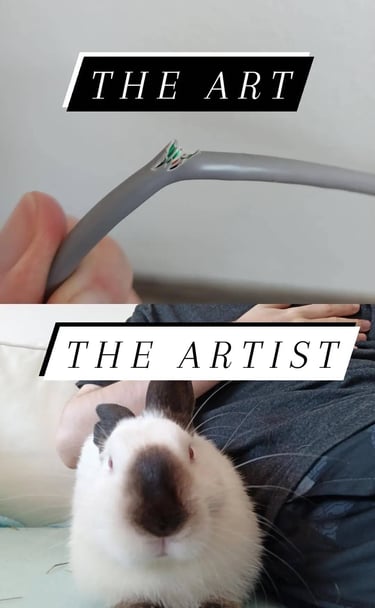

Dangerous food and chemicals
Rabbit digestion is sensitive and rabbits require a restricted, carefully monitored diet. Make sure your foster rabbit can't reach any human snacks like chocolate or chips (closed cupboards are best - your rabbit can jump much higher than you think).
House plants might look appetizing to a rabbit, but can be poisonous. Remove any house plants from reach. Don't leave any chemical cleaners or products accessible - your bun might decide to chew through the bottle.
Resource: 'Foods Rabbits Should Never Eat'




2) Keeping your rabbit healthy
Exercise
Your foster rabbit should have space to run around. Rabbits should not live in cages, as most cages are too small. If your rabbit is restricted to a playpen, ensure that it gets at least an hour of free roaming time per day.
Games can be used to help stimulate and exercise your bunny. A dig box helps your bun express their natural urge to dig. It might also prevent your bun from spending their energy on destructive behaviours.
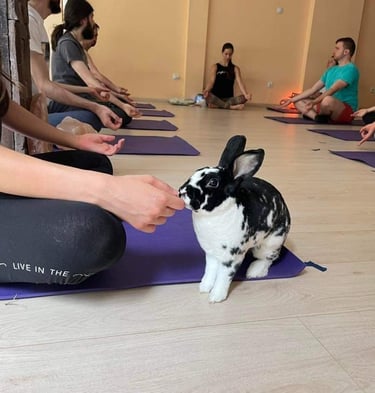

Some rabbits enjoy a yoga class occasionally.
Food and water
A leading company in small animal nutrition, Oxbow, recommends that a rabbit's diet should be around 70% hay/grass, 20% pellets, 8% fresh vegetables, and 2% fruits and healthy treats.
Provide unlimited hay for your rabbit. Once or twice a day provide a small amount of pellets and fresh vegetables.
Resource: 'What is the best type of hay for rabbits?'
Resource: 'What are the best vegetables and leafy greens for my rabbit?'
GI stasis
Rabbit digestion is constantly processing hay and other food. If this process stops for any reason (such as illness, stress, or lack of food) it can be fatal for your rabbit. Check that your rabbit is eating consistently throughout the day, and that they are pooping on a regular basis. If there is no eating or pooping for a few hours, consult with the rescue or your vet for next steps. Signs of illness can be difficult to identify in rabbits, so monitor your rabbit carefully.
Provide unlimited water for your rabbit. Place the water bowl away from the hay so you don't need to clean it out several times per day. Rabbits enjoy flipping things over, and will have no problem flipping over a light water bowl. Use a heavy bowl that cannot be easily or accidentally flipped.
Although there are water bottles aimed at rabbits, not all rabbits will use them, and there is a concern that bottles do not dispense enough water to keep your rabbit hydrated.
Having a backup water source is a good idea, especially if you are away from home and cannot refill a water bowl when needed.
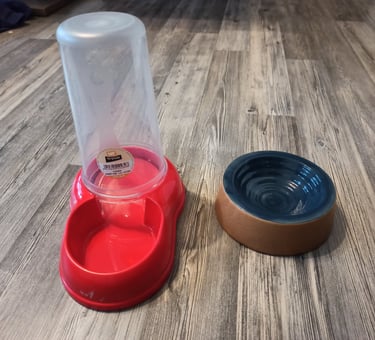

A water bowl with large capacity is useful for multiple rabbits, or as a backup water source. A small, heavy bowl is appropriate for water, but might need to be refilled several times during the day.
3) Keeping your rabbit happy
Mental stimulation
A bunny with nothing to do all day, especially if they are alone, will get depressed, and might use their excess energy for destructive behaviours like chewing your furniture. Playing with toys can be fun for your rabbit, although not all rabbits like to play. Stacking cups and slinkys (toys that can be grabbed and flipped) are popular. Provide some wooden toys or sticks (apple branches are popular) for your rabbit to chew on if they get bored.
Food can be used in games and training, which provide mental stimulation. Pellets placed in a treat ball engage the rabbit so they have to work a little for their food. Puzzle games are another good option. It might take your rabbit a little while to figure it out, but they will eventually learn what to do.
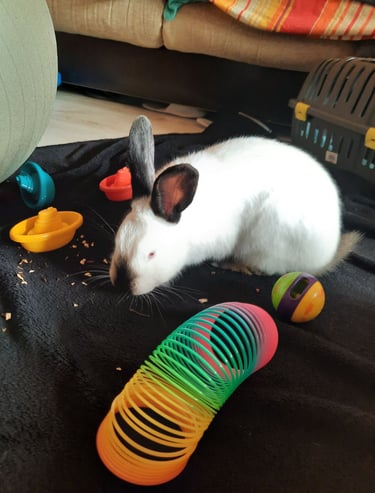

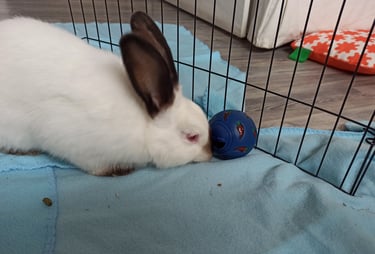

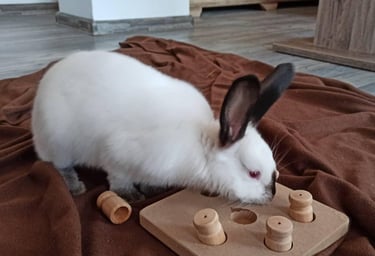

Socialization
Rabbits are social animals that depend on interaction and affection to feel happy and safe. If you are fostering a single bunny, it will be important to spend time with it every day.
If your rabbit is skittish or scared of you, go slowly with the socialization process. Take time to be in the same room together. If the rabbit will come near you, hand feed it so that it starts associating you with good things. Provide places for the rabbit to hide, so that it feels safe.
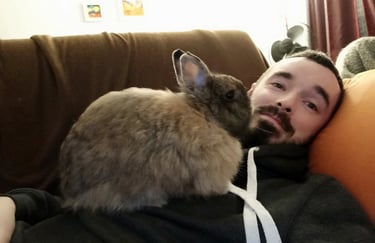

You won't always have a choice about when to socialize.
How do I know if my rabbit feels safe?
Some indications that your rabbit feels comfortable in your home include:
Coming close to you, exploring the home, being curious
Flopping, when the rabbit lies down with their belly exposed
Chinning, when the rabbit marks their territory by rubbing their chin on the environment
Binky-ing, when the rabbit does a short hop indicating happiness
When you have bonded with your rabbit, they will often seek you out, looking for food or a scratch on the head.
Resource: 'How to tell if your pet rabbit is stressed and how to help'




What's next
When you're confident that you can provide a safe and healthy environment, it's time to reach out to your local rescue about becoming a foster home. Your local rescue or shelter should be able to answer any questions or concerns you have. There is still a lot to learn, but there are plenty of great resources online.
One final important tip is to make sure that you have the contact details for a nearby exotic vet (rabbits count as an exotic pet). The rescue should be able to recommend someone. Keep these details handy in case of emergency.
By becoming a foster home, you're giving an animal a second chance at a happy life - you won't regret it. Good luck.



